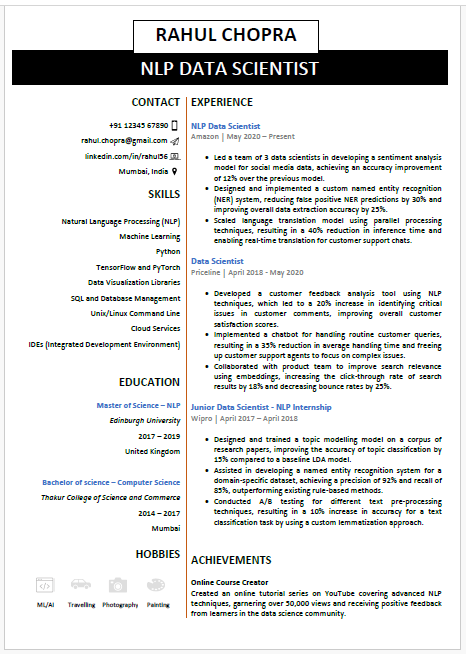NLP Data Scientist
Master of Science – NLP

About this template
This is a well-designed resume which can make a significant difference in capturing the attention of hiring managers and landing your dream job.
This resume is made by MS Word, featuring a clean and modern layout designed to highlight your skills and achievements.
Some important and common interview questions for NLP Data Scientist
For an NLP (Natural Language Processing) Data Scientist, interviews often focus on evaluating both technical expertise and problem-solving abilities related to language data. Here are ten important and common interview questions for this role:
1. Can you explain the key differences between traditional machine learning models and deep learning models in NLP?
This question assesses your understanding of various approaches in NLP. Traditional machine learning models rely on feature engineering and shallow architectures, while deep learning models, such as neural networks, automatically learn features and often achieve superior performance on complex NLP tasks.
2. How do you handle text preprocessing in NLP tasks?
Text preprocessing is crucial for effective NLP. Discuss techniques such as tokenization, stemming, lemmatization, stop-word removal, and text normalization. Explain how these steps prepare raw text for further analysis and model training.
3. What is word embedding, and how does it improve NLP model performance?
Word embeddings represent words as dense vectors, capturing semantic relationships between them. Describe how embeddings like Word2Vec, GloVe, or BERT improve model performance by providing a richer representation of words compared to one-hot encoding.
4. Can you explain how attention mechanisms work in transformer models?
Attention mechanisms, especially in transformer models like BERT and GPT, allow the model to focus on different parts of the input sequence when making predictions. Explain how self-attention helps in capturing dependencies between words in a sentence.
5. How do you evaluate the performance of an NLP model?
Evaluating NLP models involves metrics such as precision, recall, F1 score, BLEU score, or ROUGE score, depending on the task. Describe how you choose appropriate evaluation metrics and interpret them to assess model performance.
6. What challenges have you faced when working with large-scale text data, and how did you address them?
Working with large text datasets can present challenges such as data cleaning, processing efficiency, and memory constraints. Provide examples of strategies you’ve used, like distributed computing, sampling, or efficient data storage solutions.
7. Can you explain how you would approach a sentiment analysis project?
Sentiment analysis involves determining the sentiment expressed in text. Describe the steps you would take, including data collection, preprocessing, model selection (e.g., logistic regression, LSTM, BERT), and evaluation methods.
8. What is Named Entity Recognition (NER), and how would you implement it?
NER involves identifying and classifying entities like names, dates, and locations in text. Explain how you would use pre-trained models or custom-built models with techniques like CRF (Conditional Random Fields) or transformers to perform NER.
9. How do you handle imbalanced datasets in NLP tasks?
Imbalanced datasets can affect model performance. Discuss techniques such as resampling methods (oversampling/undersampling), using class weights, or employing specialized algorithms to handle class imbalance and improve model performance.
10. Can you describe a complex NLP project you’ve worked on and the impact it had?
This question assesses your practical experience and problem-solving abilities. Provide a detailed example of an NLP project, including the problem, your approach, the technologies used, and the results or impact achieved.
Conclusion:
These questions help interviewers gauge your expertise in NLP techniques, problem-solving skills, and practical experience in applying NLP methods to real-world data.